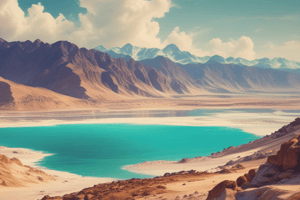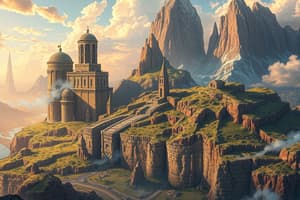Podcast
Questions and Answers
Which physiographical region of Canada is characterized by flat, fertile land, making it ideal for agriculture?
Which physiographical region of Canada is characterized by flat, fertile land, making it ideal for agriculture?
- The Cordillera Mountains
- The Appalachian Mountains
- The Canadian Shield
- The Interior Plains (correct)
The Earth's inner core is composed primarily of liquid iron and nickel.
The Earth's inner core is composed primarily of liquid iron and nickel.
False (B)
What type of tectonic plate boundary is characterized by plates sliding past each other horizontally?
What type of tectonic plate boundary is characterized by plates sliding past each other horizontally?
Transform boundary
__________ is a type of geological alteration that occurs when hot water reacts with rocks, changing their mineral composition.
__________ is a type of geological alteration that occurs when hot water reacts with rocks, changing their mineral composition.
Match the following processes with their primary actions:
Match the following processes with their primary actions:
Which erosion process is most prominent in arid regions, involving the transport of sand and dust over long distances?
Which erosion process is most prominent in arid regions, involving the transport of sand and dust over long distances?
Tectonic forces are considered gradational forces that wear down surface materials.
Tectonic forces are considered gradational forces that wear down surface materials.
What potential environmental impact is most directly associated with forestry practices like clear-cutting?
What potential environmental impact is most directly associated with forestry practices like clear-cutting?
__________ was the name of the supercontinent that existed millions of years ago, comprising all the major landmasses.
__________ was the name of the supercontinent that existed millions of years ago, comprising all the major landmasses.
Tuzo Wilson is best known for his concepts of hotspots and what other geological feature?
Tuzo Wilson is best known for his concepts of hotspots and what other geological feature?
Which of Earth's layers is responsible for generating Earth's magnetic field?
Which of Earth's layers is responsible for generating Earth's magnetic field?
At divergent plate boundaries, plates move toward each other, resulting in subduction or mountain building.
At divergent plate boundaries, plates move toward each other, resulting in subduction or mountain building.
Name one of the primary agents involved in the erosion process.
Name one of the primary agents involved in the erosion process.
The Canadian __________ is a vast expanse of ancient rock, forming the geological core of Canada.
The Canadian __________ is a vast expanse of ancient rock, forming the geological core of Canada.
Which physiographic region is known for its towering peaks and valleys in western Canada?
Which physiographic region is known for its towering peaks and valleys in western Canada?
Which of the following is a consequence of mining activities?
Which of the following is a consequence of mining activities?
Alfred Wegener's theory of continental drift was immediately accepted by the scientific community.
Alfred Wegener's theory of continental drift was immediately accepted by the scientific community.
Match the Earth's layers with their descriptions:
Match the Earth's layers with their descriptions:
Flashcards
Canadian Shield
Canadian Shield
A vast expanse of ancient rock forming Canada's geological core.
Interior Plains
Interior Plains
Flat, fertile land in central Canada, ideal for farming.
Great Lakes-St. Lawrence Lowlands
Great Lakes-St. Lawrence Lowlands
Fertile and densely populated area around the Great Lakes and St. Lawrence River.
Appalachian Mountains
Appalachian Mountains
Signup and view all the flashcards
Cordillera Mountains
Cordillera Mountains
Signup and view all the flashcards
Arctic Lands
Arctic Lands
Signup and view all the flashcards
Hudson Bay Lowlands
Hudson Bay Lowlands
Signup and view all the flashcards
Earth's Crust
Earth's Crust
Signup and view all the flashcards
Earth's Mantle
Earth's Mantle
Signup and view all the flashcards
Earth's Outer Core
Earth's Outer Core
Signup and view all the flashcards
Earth's Inner Core
Earth's Inner Core
Signup and view all the flashcards
Divergent Boundaries
Divergent Boundaries
Signup and view all the flashcards
Convergent Boundaries
Convergent Boundaries
Signup and view all the flashcards
Transform Boundaries
Transform Boundaries
Signup and view all the flashcards
Weathering
Weathering
Signup and view all the flashcards
Erosion
Erosion
Signup and view all the flashcards
Metamorphism
Metamorphism
Signup and view all the flashcards
Hydrothermal Alteration
Hydrothermal Alteration
Signup and view all the flashcards
Mass Wasting
Mass Wasting
Signup and view all the flashcards
Alfred Wegener
Alfred Wegener
Signup and view all the flashcards
Study Notes
The provided text is identical to the existing notes. Therefore, no updates are necessary.
Studying That Suits You
Use AI to generate personalized quizzes and flashcards to suit your learning preferences.




